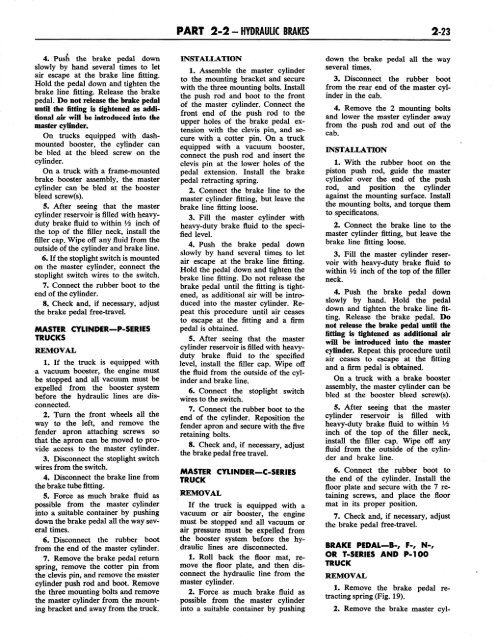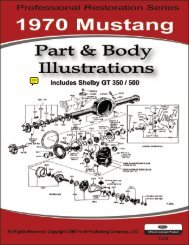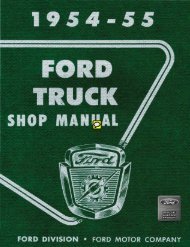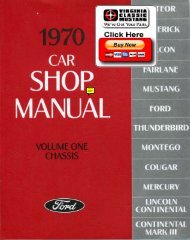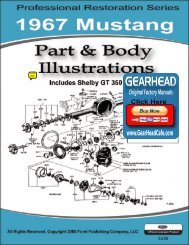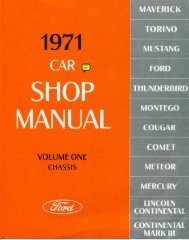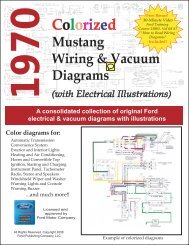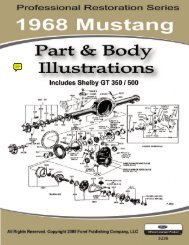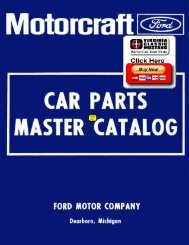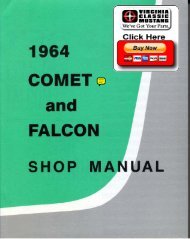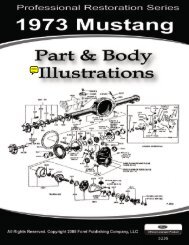DEMO - 1965 Ford Truck Shop Manual - ForelPublishing.com
DEMO - 1965 Ford Truck Shop Manual - ForelPublishing.com
DEMO - 1965 Ford Truck Shop Manual - ForelPublishing.com
You also want an ePaper? Increase the reach of your titles
YUMPU automatically turns print PDFs into web optimized ePapers that Google loves.
PART 2-2 - HYDRAULIC BRAKES 2-23<br />
4. Push the brake pedal down<br />
slowly by hand several times to let<br />
air escape at the brake line fitting.<br />
Hold the pedal down and tighten the<br />
brake line fitting. Release the brake<br />
pedal. Do not release the brake pedal<br />
until the fitting is tightened as additional<br />
air will be introduced into the<br />
master cylinder.<br />
On trucks equipped with dashmounted<br />
booster, the cylinder can<br />
be bled at the bleed screw on the<br />
cylinder.<br />
Gn a truck with a frame-mounted<br />
brake booster assembly, the master<br />
cylinder can be bled at the booster<br />
bleed screw(s).<br />
5. After seeing that the master<br />
cylinder reservoir is filled with heavyduty<br />
brake fluid to within Vi inch of<br />
the top of the filler neck, install the<br />
filler cap. Wipe off any fluid from the<br />
outside of the cylinder and brake line.<br />
6. If the stoplight switch is mounted<br />
on the master cylinder, connect the<br />
stoplight switch wires to the switch.<br />
7. Connect the rubber boot to the<br />
end of the cylinder.<br />
8. Check and, if necessary, adjust<br />
the brake pedal free-travel.<br />
MASTER CYLINDER—P-SERIES<br />
TRUCKS<br />
REMOVAL<br />
1. If the truck is equipped with<br />
a vacuum booster, the engine must<br />
be stopped and all vacuum must be<br />
expelled from the booster system<br />
before the hydraulic lines are disconnected.<br />
2. Turn the front wheels all the<br />
way to the left, and remove the<br />
fender apron attaching screws so<br />
that the apron can be moved to provide<br />
access to the master cylinder.<br />
3. Disconnect the stoplight switch<br />
wires from the switch.<br />
4. Disconnect the brake line from<br />
the brake tube fitting.<br />
5. Force as much brake fluid as<br />
possible from the master cylinder<br />
into a suitable container by pushing<br />
down the brake pedal all the way several<br />
times.<br />
6. Disconnect the rubber boot<br />
from the end of the master cylinder.<br />
7. Remove the brake pedal return<br />
spring, remove the cotter pin from<br />
the clevis pin, and remove the master<br />
cylinder push rod and boot. Remove<br />
the three mounting bolts and remove<br />
the master cylinder from the mounting<br />
bracket and away from the truck.<br />
INSTALLATION<br />
1. Assemble the master cylinder<br />
to the mounting bracket and secure<br />
with the three mounting bolts. Install<br />
the push rod and boot to the front<br />
of the master cylinder. Connect the<br />
front end of the push rod to the<br />
upper holes of the brake pedal extension<br />
with the clevis pin, and secure<br />
with a cotter pin. On a truck<br />
equipped with a vacuum booster,<br />
connect the push rod and insert the<br />
clevis pin at the lower holes of the<br />
pedal extension. Install the brake<br />
pedal retracting spring.<br />
2. Connect the brake line to the<br />
master cylinder fitting, but leave the<br />
brake line fitting loose.<br />
3. Fill the master cylinder with<br />
heavy-duty brake fluid to the specified<br />
level.<br />
4. Push the brake pedal down<br />
slowly by hand several times to let<br />
air escape at the brake line fitting.<br />
Hold the pedal down and tighten the<br />
brake line fitting. Do not release the<br />
brake pedal until the fitting is tightened,<br />
as additional air will be introduced<br />
into the master cylinder. Repeat<br />
this procedure until air ceases<br />
to escape at the fitting and a firm<br />
pedal is obtained.<br />
5. After seeing that the master<br />
cylinder reservoir is filledwith heavyduty<br />
brake fluid to the specified<br />
level, install the filler cap. Wipe off<br />
the fluid from the outside of the cylinder<br />
and brake line.<br />
6. Connect the stoplight switch<br />
wires to the switch.<br />
7. Connect the rubber boot to the<br />
end of the cylinder. Reposition the<br />
fender apron and secure with the five<br />
retaining bolts.<br />
8. Check and, if necessary, adjust<br />
the brake pedal free travel.<br />
MASTER CYLINDER—C-SERIES<br />
TRUCK<br />
REMOVAL<br />
If the truck is equipped with a<br />
vacuum or air booster, the engine<br />
must be stopped and all vacuum or<br />
air pressure must be expelled from<br />
the booster system before the hydraulic<br />
lines are disconnected.<br />
1. Roll back the floor mat, remove<br />
the floor plate, and then disconnect<br />
the hydraulic line from the<br />
master cylinder.<br />
2. Force as much brake fluid as<br />
possible from the master cylinder<br />
into a suitable container by pushing<br />
down the brake pedal all the way<br />
several times.<br />
3. Disconnect the rubber boot<br />
from the rear end of the master cylinder<br />
in the cab.<br />
4. Remove the 2 mounting bolts<br />
and lower the master cylinder away<br />
from the push rod and out of the<br />
cab.<br />
INSTALLATION<br />
1. With the rubber boot on the<br />
piston push rod, guide the master<br />
cylinder over the end of the push<br />
rod, and position the cylinder<br />
against the mounting surface. Install<br />
the mounting bolts, and torque them<br />
to specificatons.<br />
2. Connect the brake line to the<br />
master cylinder fitting, but leave the<br />
brake line fitting loose.<br />
3. Fill the master cylinder reservoir<br />
with heavy-duty brake fluid to<br />
within Vi inch of the top of the filler<br />
neck.<br />
4. Push the brake pedal down<br />
slowly by hand. Hold the pedal<br />
down and tighten the brake line fitting.<br />
Release the brake pedal. Do<br />
not release the brake pedal until the<br />
fitting is tightened as additional air<br />
will be introduced into the master<br />
cylinder. Repeat this procedure until<br />
air ceases to escape at the fitting<br />
and a firm pedal is obtained.<br />
On a truck with a brake booster<br />
assembly, the master cylinder can be<br />
bled at the booster bleed screw(s).<br />
5. After seeing that the master<br />
cylinder reservoir is filled with<br />
heavy-duty brake fluid to within Vi<br />
inch of the top of the filler neck,<br />
install the filler cap. Wipe off any<br />
fluid from the outside of the cylinder<br />
and brake line.<br />
6. Connect the rubber boot to<br />
the end of the cylinder. Install the<br />
floor plate and secure with the 7 retaining<br />
screws, and place the floor<br />
mat in its proper position.<br />
7. Check and, if necessary, adjust<br />
the brake pedal free-travel.<br />
BRAKE PEDAL-B-, F-, N-,<br />
OR T-SERIES AND P-100<br />
TRUCK<br />
REMOVAL<br />
1. Remove the brake pedal retracting<br />
spring (Fig. 19).<br />
2. Remove the brake master cyl-


